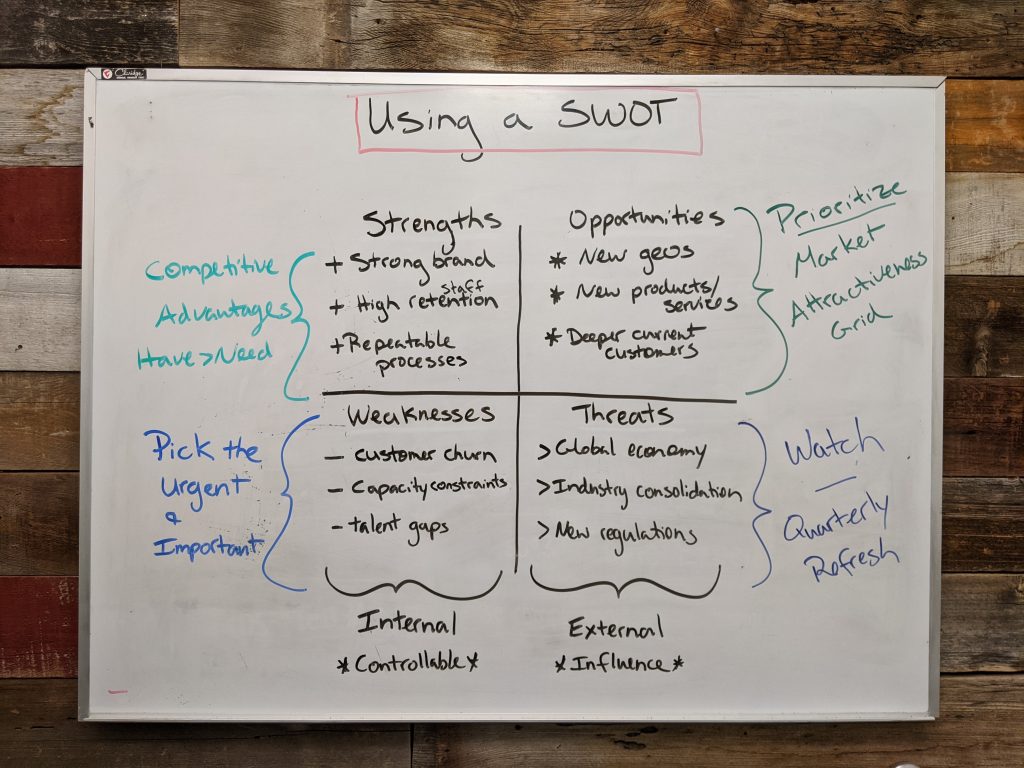Putting Your SWOT to Use
A SWOT is an awesome tool. Let’s learn how to use it and put it to work. In today’s tutorial, we will show you how to take items from your SWOT and turn them into goals, actions, and other elements of your strategic plan.
Video Transcription
Building your SWOT is only one part of the puzzle. To complete your SWOT analysis, it’s essential to learn how to use all those sticky notes and put it to use.
Most of the time you go through the whole exercise of research, internal/external sessions, and sticky notes to build a great SWOT. But, once it’s complete, you don’t use it to build your plan because nobody knows what to do with it! Today we are going to rescue that problem!
Get the Free Guide and Canvas to Create a SWOT Analysis
Tip #1: Organize your SWOT under your strategic objectives. (For big SWOTs)
If you have a SWOT that’s massive, maybe 20, 25, 30 points under each of your 4 quadrants, our suggestion is to take it apart and organize it under your strategic objectives. It looks like putting a “mini SWOT” for each of your strategic objectives.
But if your SWOT is not massive don’t do this!
Tip #2: Goal/Initiative Hunting
Strengths:
For our strengths we have a few examples: strong brand, high staff retention, repeatable processes. Those all might be strengths. Remember, our strengths and weaknesses are internal, and they’re controllable. If you want to bump up your strengths, you can. You have control to do so, resources notwithstanding.
Same thing with weaknesses. You can solve these things if you choose to do so. This keeps both sides of your SWOT working for you.
The strengths quadrant is a really great place to identify competitive advantages. Some of them may actually be current, competitive advantages. Others might be those that you need to develop. In that case, those are great candidates for initiatives.
Weaknesses:
Now with your weaknesses, what do you do with them? Normally there’s a lot here. Remember, we said you can control them, or change them, or turn them into strengths if you wanted to and need to.
A suggestion would be to pick the urgent and important. A simple way to do that is a lot of times you just know those items that you absolutely need to tackle. If there’s really too many of them, and you need a better process, use an effort impact grid to determine which of these you absolutely need to move forward. Effort impacts them, and you’ll know which weaknesses you need to turn into goals or initiatives.
Opportunities:
The right side of your SWOT is external. It’s what you can influence. Remember, opportunities are how we’re going to grow. Normally there’s more opportunities than any organization can tackle. What do we do with that? We need to prioritize them. We prioritize them using a market attractiveness grid – you can watch the video and download the free guide here!
Threats:
Honestly, most SWOTs don’t have a ton of threats. We don’t love threats, but they’re super important to be aware of and watch. You need to watch those that are important. And you would bring those into your quarterly refreshes to determine whether or not you need to turn them into initiatives. Your initiatives come from those competitive advantages that you need to create, those weaknesses that are urgent and important, and those opportunities that you’re prioritizing.














Great video except that it kept freezing up.